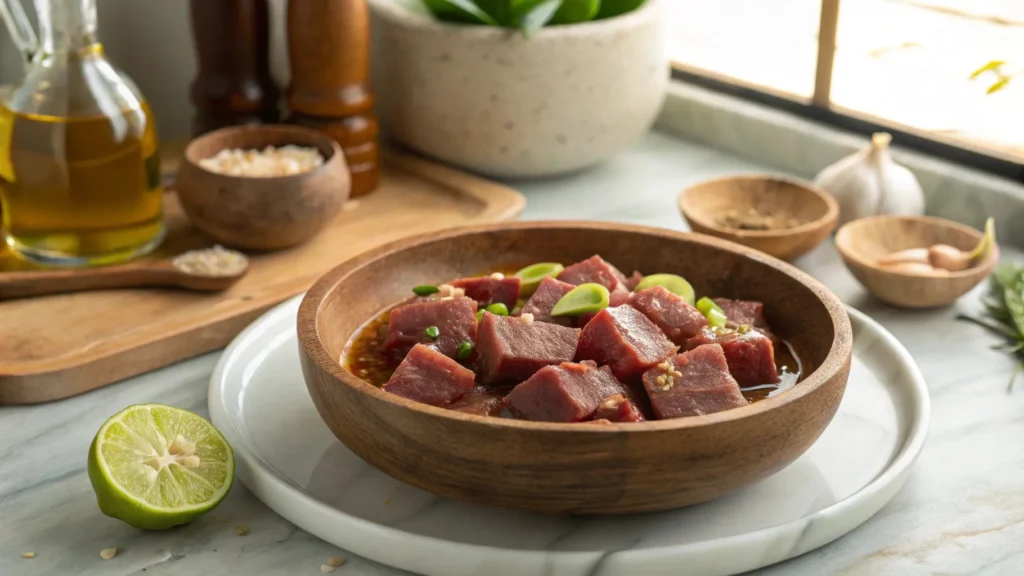Beef Mechado Recipe. Have you ever found yourself craving a dish that’s rich, hearty, and bursting with complex flavors? Look no further than beef mechado, a Filipino culinary treasure that combines savory, tangy, and slightly sweet notes into one unforgettable meal. This beloved dish has graced Filipino family tables for generations, earning its place as a cornerstone of the country’s diverse food landscape.
5 reasons why you’ll love Beef Mechado 😋🍛:
Rich, hearty flavor – Slow-cooked beef infused with tomato sauce and spices makes every bite unforgettable 🥩🍅
Comfort food classic – Perfect for cozy dinners and family gatherings 🏠❤️
Versatile – Great with rice, bread, or even mashed potatoes 🍚🥖🥔
Meal-prep friendly – Tastes even better the next day and freezes well 🧊🍽️
Nutritious – Packed with protein, iron, and essential nutrients for a balanced diet 💪🥦
What is Beef Mechado? Origin and Cultural Significance
Before we dive into the nitty-gritty of preparation, let’s take a moment to understand what exactly makes a dish mechado. At its core, beef mechado is a Filipino tomato-based stew featuring tender chunks of beef slowly simmered with vegetables in a sauce that strikes a perfect balance between tangy and savory. The name “mechado” comes from the Spanish word “mecha,” meaning wick, which refers to the traditional preparation method where fat is inserted into the cheaper cuts of meat—similar to how a wick is inserted into a candle.
Essential Ingredients for an Authentic Beef Mechado
Creating truly exceptional beef mechado begins with selecting the right ingredients. While substitutions can be made in a pinch (we’ll discuss those later), understanding the role of each traditional component helps maintain the dish’s authentic character.

Traditional vs. Modern Ingredient Substitutions
While purists might insist on strictly traditional ingredients, the reality is that many Filipino home cooks—especially those living abroad—have found creative ways to adapt their mechado recipes when authentic components aren’t available. Here are some common substitutions that won’t compromise the essence of the dish:
For calamansi juice:
- Lemon juice mixed with a touch of orange juice
- A combination of lime and mandarin orange juice
- White wine vinegar diluted with a bit of water and sugar
For Filipino soy sauce (toyo):
- Regular soy sauce with a pinch of additional salt
- Light soy sauce (not low-sodium, but the Chinese light variety)
- Tamari for a gluten-free option
For liver spread:
- Puréed chicken livers cooked with a bit of butter
- Anchovy paste (use sparingly)
- Beef bouillon paste with a teaspoon of cocoa powder (sounds strange but adds comparable richness and depth)
For lard or traditional cooking oils:
- Canola or vegetable oil
- Olive oil (though this introduces a different flavor profile)
- Beef tallow for those seeking traditional richness
Step-by-Step Beef Mechado Preparation Guide
Now that we understand the ingredients, let’s dive into the process of creating this magnificent dish. I’ve broken it down into stages to make it manageable even for those new to Filipino cuisine.
Marinating Techniques for Maximum Flavor
One secret to extraordinary beef mechado is proper marination. This step allows the meat to absorb flavors before it ever meets the heat, creating layers of taste that simple cooking can’t achieve.
Basic Marination Method:
- In a large bowl, combine 3 tablespoons of soy sauce, 2 tablespoons of calamansi juice (or substitute), 4 cloves of minced garlic, and freshly ground black pepper.
- Add your beef chunks (about 2 pounds, cut into 2-inch cubes) and toss to coat evenly.
- Cover and refrigerate for at least 1 hour, though 3-4 hours yields better results. For truly transformative flavor development, marinate overnight.
- During longer marination periods, toss the meat occasionally to ensure even exposure to the marinade.
The acid in the calamansi juice helps tenderize the meat while the soy sauce contributes salt and umami compounds that penetrate the beef. Meanwhile, the garlic infuses its aromatic oils throughout the mixture. This pre-cooking flavor foundation makes a remarkable difference in the final dish.
For an extra flavor boost, consider these marination enhancements:
- Add a tablespoon of finely grated ginger for subtle warmth
- Include half a grated onion for sweetness and additional tenderizing enzymes
- Incorporate a tablespoon of brown sugar to promote caramelization during searing
- Add a splash of banana ketchup (a Filipino staple) for subtle sweetness and complexity
Whether you opt for the basic marinade or an enhanced version, don’t skip this crucial step. The difference between marinated and non-marinated meat is immediately apparent in the final dish.
The Art of Searing Beef for Mechado
While some home cooks might be tempted to simply throw all ingredients into a pot and simmer, properly searing the beef first is essential for developing the deep, complex flavors that make exceptional mechado.
Searing Process:
- Remove the marinated beef from the refrigerator about 30 minutes before cooking to take the chill off.
- Drain the marinade, reserving the liquid for later use. Pat the beef pieces dry with paper towels—this is crucial for proper searing.
- Heat 2 tablespoons of oil in a heavy-bottomed pot or Dutch oven over medium-high heat until it’s shimmering but not smoking.
- Working in batches to avoid overcrowding (which causes steaming rather than searing), place beef pieces in the pot with space between them.
- Let them cook undisturbed for 2-3 minutes until a deep brown crust forms, then turn to sear all sides.
- Remove seared pieces to a plate and continue with remaining beef.
The searing process creates what food scientists call the Maillard reaction—a chemical reaction between amino acids and reducing sugars that creates hundreds of new flavor compounds. This is what gives properly prepared mechado its complex, savory depth that simple boiling could never achieve.
Don’t rush this stage or skip it entirely. The few extra minutes spent on proper searing will elevate your mechado from good to unforgettable.
Simmering Methods for Tender, Flavorful Results
Once you’ve properly seared your beef, we move to the heart of mechado preparation: the simmering process. This is where patience truly becomes a virtue, as rushing this step can leave you with tough meat and underdeveloped flavors.
The Simmering Process:
- Using the same pot where you seared the beef (don’t clean it—those browned bits are flavor gold!), lower the heat to medium and add 1 large diced onion. Sauté until translucent, about 3-4 minutes.
- Add 6 cloves of minced garlic and cook for another minute until fragrant.
- Pour in 2 tablespoons of tomato paste and stir to coat the onions and garlic, cooking for 1-2 minutes to caramelize the paste slightly.
- Add the reserved marinade and deglaze the pot, scraping up all those flavorful browned bits from the bottom.
- Return the seared beef to the pot, then add:
- 2 cups of tomato sauce or crushed tomatoes
- 1 cup of beef broth
- 3 bay leaves
- 2 tablespoons of soy sauce
- 1 tablespoon of fish sauce (optional but recommended)
- 2 tablespoons of liver spread (if using)
- Bring the mixture to a gentle boil, then reduce to a low simmer. Cover and cook for 1.5-2 hours, until the beef is beginning to become tender.
- Add 2 large potatoes (cut into chunks), 2 carrots (sliced), and 1 red bell pepper (cut into strips).
- Continue simmering for another 30-45 minutes until vegetables are tender and beef easily breaks apart with light pressure.
- Taste and adjust seasoning with salt, pepper, and additional calamansi juice as needed.

🥘 Beef Mechado: A Hearty and Flavorful Filipino Stew 🇵🇭
- Total Time: 2 hours
- Yield: 6 servings
- Diet: Gluten Free
Description
Craving a warm, comforting meal? 🤤 Beef Mechado is the perfect dish! This classic Filipino stew features tender beef chunks slow-cooked in a rich, savory tomato sauce, infused with garlic, onions, and a hint of citrus for that perfect balance of flavors. 🥩🍅🥕 The addition of potatoes, carrots, and bell peppers makes it even heartier—perfect for a family feast! 👨👩👧👦 Serve it with a bowl of steaming white rice, and you’ve got a meal that feels like a warm hug in every bite. 🤗✨
Ingredients
- 2 lbs beef chuck or brisket, cut into 1.5-inch cubes
- 2 tbsp soy sauce
- 2 tbsp calamansi juice or lemon juice
- 3 tbsp cooking oil
- 3 cloves garlic, minced
- 1 large onion, chopped
- 1 cup tomato sauce
- 1 cup beef broth or water
- 2 bay leaves
- 2 medium potatoes, peeled and quartered
- 1 large carrot, sliced into rounds
- 1 red bell pepper, sliced
- Salt and pepper to taste
Instructions
Marinate the Beef: In a bowl, combine beef cubes, soy sauce, and calamansi (or lemon) juice. Let it marinate for at least 30 minutes to absorb the flavors.
Sear the Beef: In a large pot, heat cooking oil over medium-high heat. Add the marinated beef, searing until browned on all sides. Remove and set aside.
Sauté Aromatics: In the same pot, sauté garlic and onions until fragrant and translucent.
Build the Sauce: Return the seared beef to the pot. Pour in tomato sauce and beef broth (or water). Add bay leaves. Stir to combine.
Simmer: Bring the mixture to a boil. Reduce heat to low, cover, and let it simmer for about 1 to 1.5 hours, or until the beef becomes tender.
Add Vegetables: Once the beef is tender, add potatoes and carrots. Continue to simmer until vegetables are cooked through, approximately 15-20 minutes.
Finalize: Stir in red bell pepper slices. Season with salt and pepper to taste. Cook for an additional 5 minutes.
Serve: Remove bay leaves. Transfer the stew to a serving dish and enjoy hot, preferably with steamed white rice.
Notes
- Meat Selection: Traditionally, leaner cuts of beef were larded with pork fat to enhance moisture and flavor. Modern recipes often use marbled cuts like chuck or brisket to achieve tenderness without additional fat.
- Flavor Enhancements: Some variations incorporate soy sauce and calamansi juice to introduce a subtle tanginess, balancing the rich tomato base.
- Cooking Methods: For quicker preparation, a pressure cooker can reduce cooking time significantly.
- Prep Time: 20 minutes
- Cook Time: 1 hour 40 minutes
- Category: Main Course
- Method: Braising
- Cuisine: Filipino

Frequently Asked Questions About Beef Mechado
Q: What’s the difference between mechado, afritada, and kaldereta? A: These three tomato-based Filipino stews often cause confusion. Mechado traditionally features beef with a distinctive soy sauce and citrus component in its tomato base. Afritada typically uses chicken in a simpler tomato sauce with bell peppers and often includes green peas. Kaldereta uses goat or beef in a tomato sauce enriched with liver spread and often incorporates olives and sometimes cheese for a creamier texture. While similar, each has its distinctive character and traditional protein.
Q: Can I make mechado in a slow cooker or Instant Pot? A: Absolutely! For a slow cooker, sear the meat and sauté aromatics separately, then combine all ingredients and cook on low for 7-8 hours or high for 4-5 hours. Add vegetables during the last 1-2 hours. For an Instant Pot, use the sauté function for the preliminary steps, then pressure cook on high for 35 minutes for chuck roast (adjust for other cuts), followed by a 15-minute natural release. Add vegetables and pressure cook for an additional 3-5 minutes.
Q: How can I make my mechado taste more like my Filipino grandmother’s? A: The “lola (grandmother) factor” often comes down to patience and a few special touches. Try these: (1) Marinate the beef overnight rather than for just an hour, (2) Use banana ketchup as part of your tomato component—many traditional cooks include this distinctively Filipino ingredient, (3) Don’t rush the initial sautéing of onions and garlic—this foundation of flavor needs time to develop, (4) Consider whether your grandmother used liver spread, and if so, make sure to include it, and (5) Many traditional cooks add a pinch of MSG, which enhances the umami quality of the dish.
Ready to explore more? Visit these recipes for additional inspiration and ideas.
Beef Mechado is a hearty and flavorful dish that pairs well with other comforting meals. If you enjoy rich, slow-cooked beef dishes, you might also like this Beef Neck Bones Recipe, which offers another way to create tender, fall-off-the-bone meat. For a different take on beef, try this Mediterranean Ground Beef Stir-Fry, packed with bold spices and fresh ingredients. And if you’re in the mood for a delicious side, these Crispy Cheesy Potato Puffs make the perfect crunchy complement to your Mechado. Looking for more inspiration? Learn How to Cook Beef Back Ribs in the Oven for another fantastic beef recipe.
Conclusion: Mastering the Art of Beef Mechado
The journey to creating perfect beef mechado is both an exploration of Filipino culinary history and an opportunity to create a dish that will become part of your own family’s food tradition. From its Spanish-influenced origins to its modern interpretations, mechado represents the beautiful adaptability and depth of Filipino cuisine.
Masarap! (Delicious!)

